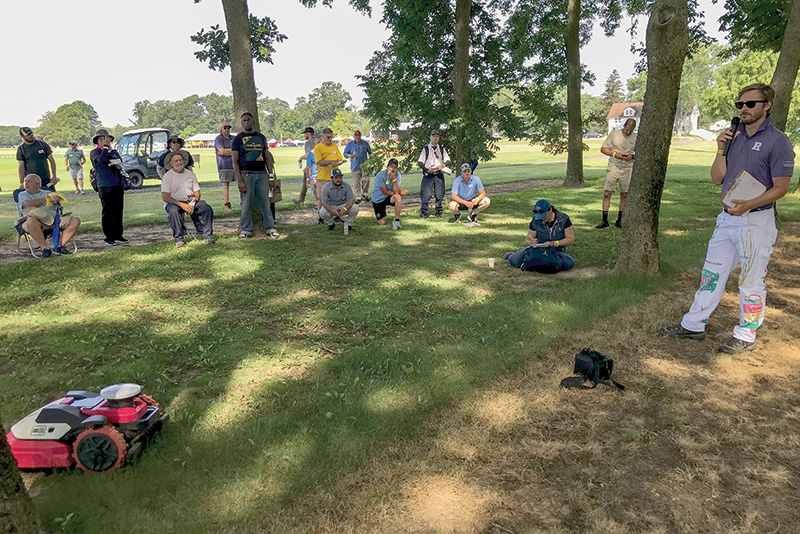
Attendees enjoy a turfgrass shade tolerance presentation … in the shade. Photo by Darrell J. Pehr
Of the two dozen research projects presented during the annual Rutgers Turfgrass Research Field Days July 29-30, my favorites were the shade studies.
Of course, I am a science editor, not a superintendent, and I have no overly shaded golf course fairways or greens to be concerned about. But, as the sunny July day soared to near 100 degrees, it sure was nice to stay in the shade as Rutgers graduate assistant Eric MacPherson outlined a study on breeding bentgrass for shade tolerance and putting green quality.
MacPherson’s project was one of 12 excellent presentations during the first day of the event, focusing on golf and fine turf at Rutgers’ Hort Farm 2 in North Brunswick, N.J. Other topics covered evaluation of Kentucky bluegrass under deficit irrigation using remote sensing technology, led by graduate student researcher Devan Gladden and Bingru Huang, Ph.D.; breeding bentgrass for fairways, led by Stacy Bonos, Ph.D.; and blue-green algae control on a golf course putting green, a project with funding from GCSAA, led by Ming-Yi Chou, Ph.D.
Day 2, although not forecast to be quite as hot at Rutgers’ nearby Adelphia Farm in Freehold, N.J., included a second shade study, also presented by MacPherson, this time in a wonderfully cool pecan orchard. I could have stayed there all day, but more learning opportunities coaxed me back into the open, where the topics centered on lawn, landscape and sports fields.
Among the 12 presentations, Bonos outlined a 2024 tall fescue trial and breeding project focused on developing disease resistance and other traits; Katie Tuck and Matthew Elmore, Ph.D., led a talk on various species of paspalum and methods of control; and graduate research assistant Ryan Earp gave an update on the 2023 NTEP Kentucky bluegrass trial and breeding project for improved disease resistance.
The event was put on by the Rutgers Center for Turfgrass Science and New Jersey Turfgrass Association with support from the Sports Field Managers Association of New Jersey and the GCSA of New Jersey.
The handout for the field days included something I had not seen at other turfgrass field days: suggestions for observing and interpreting turfgrass research. Some of the tips were specific to the Rutgers event, but others could be helpful at any field day, such as:
Pick out the best treatments for each test, but do not overlook the assortment of poor treatments. These may not be as interesting, but they tell you a lot of things that you should not use on your turf.
Remember, things may happen in our research plots or on your turf areas that may not commonly occur every year. Thus, when dealing with new treatments, look for assurance that they work consistently, or find out why inconsistencies occur.
Remember also that our soil and management practices (including traffic, slope and age of turf) may differ from your conditions, so your experiences may not always agree with ours.
With more field days to come, such as the University of California-Riverside field day Sept. 11, and the recently announced Penn State Golf Turf Conference Nov. 18-20, these tips might come in handy to attendees.
I would also add a tip of my own: Though it’s probably not important in the chilly Pennsylvania November but certainly possible in the still toasty weather of Riverside in September, keep your eyes peeled for shade studies.
Darrell J. Pehr is GCM’s science editor.